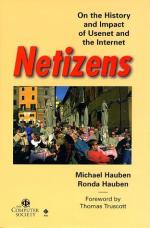|
This section contains 386 words (approx. 2 pages at 300 words per page) |
USENET is an electronic discussion network that is disseminated worldwide. USENET is comprised of a set of newsgroups with names that are classified by subject. Messages can be sent to whatever newsgroup a user with a computer and the appropriate software wishes. These transmissions can then be broadcast via other networks to a wider audience.
The concept of a computer-networked newsgroup was proposed in 1977 by Tom Truscott and Jim Elis, then graduate students at Duke University in North Carolina. Afterwards, Steve Bellovin, also a graduate student at the University of North Carolina, wrote the first version of the news software. Further refinements increased the sophistication and the popularity of the newsgroup network. Rick Adams, then of the Center for Seismic Studies, took over coordination of the maintenance and enhancement of the news software in 1984. Under Adams' guidance, USENET took on its present form, with its greater diversity of newsgroups and hieratical structure, in late 1986.
The newsgroups are organized according to their specific areas of interest. Since the organization is a tree structure, the various groups are called hierarchies. There are seven major categories into which the newsgroups fit: comp (computer and computer science-related groups), misc (a general category for groups not fitting elsewhere), sci (science-related groups), soc (groups addressing social issues and socializing), talk (debate and discussion groups), news (news and software groups), and rec (recreation and hobby groups). Alternative hierarchies exist as well, among which are alt (a free form group), gnu (concerned with the GNU Project), and biz (business-related groups).
Some USENET newsgroups are moderated; postings are first vetted by a moderator for approval prior to their appearance in the newsgroup. Moderation is intended to keep newsgroup discussion focused on the relevant topics. Many other newsgroups are not moderated, and postings appear with no prior inspection.
The nature of the newsgroups that comprise the USENET is subject to debate. Definitions include those newsgroups listed in the "List of Active Newsgroups" or "Alternative Newsgroup Hierarchies" postings in news.lists.misc.
The free access to USENET has been maliciously exploited by some. As well, some un-moderated newsgroups have become chaotic and unfocussed. To counteract this behavior, USENET II has been created. Access to USENET II is more restricted than access to USENET, in an effort to promote more of an atmosphere of information exchange.
|
This section contains 386 words (approx. 2 pages at 300 words per page) |


